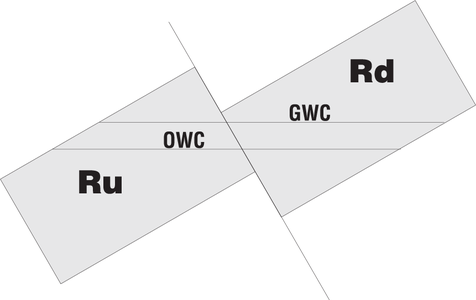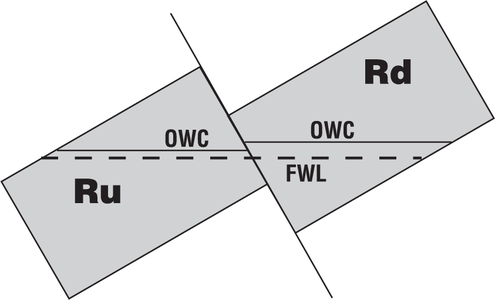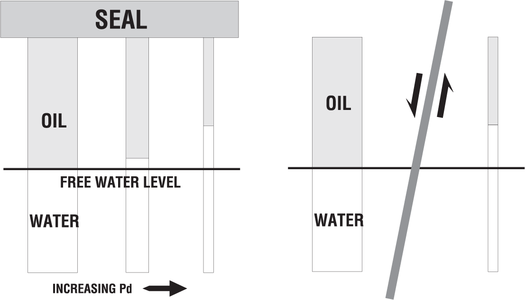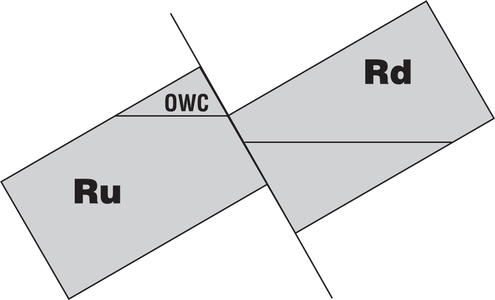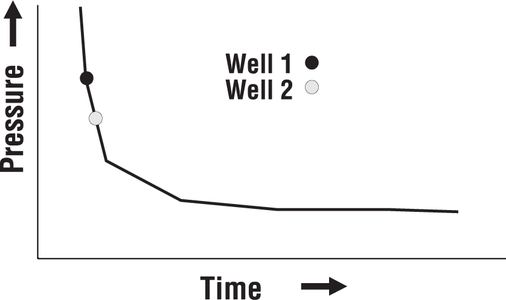Cross-leaking fault
| Exploring for Oil and Gas Traps | |

| |
| Series | Treatise in Petroleum Geology |
|---|---|
| Part | Predicting the occurrence of oil and gas traps |
| Chapter | Evaluating top and fault seal |
| Author | Grant M. Skerlec |
| Link | Web page |
| Store | AAPG Store |
A cross-leaking fault allows lateral communication of hydrocarbons between juxtaposed reservoirs. Cross-leaking faults can be identified using any of the following criteria:
- Common hydrocarbon contacts
- Common free water levels (FWL)
- Juxtaposed lithology leak points (JLLP)
- Common pressures
Common hydrocarbon contacts[edit]
Common hydrocarbon contacts imply communication across the fault and cross leakage. The cross-leaking fault in Figure 1 shows two sands, Ru and Rd, juxtaposed by a fault. The two sands have common oil-water(OWC) and gas-water (GWC) contacts. The fault is cross leaking to both oil and gas.
Common free-water levels[edit]
A cross-leaking fault can have different hydrocarbon contacts across the fault. The difference in hydrocarbon contacts can be caused not by the fault zone material but by differences in the displacement pressure (Pd) of the juxtaposed reservoirs. There is, however, a common free-water level (FWL).
An example of a cross-leaking fault with different OWCs and a common FWL is shown in Figure 2. The Pd of the Rd sand is greater than that of the Ru sand. The fault is cross leaking despite different OWCs.
Capillarity and OWCs[edit]
Figure 3 illustrates the effect of capillary properties on oil-water contacts. Decreasing pore throat radius, represented by three capillary tubes of decreasing diameter (left), creates a higher OWC within the reservoir. If the pore throat is large (low Pd), the OWC coincides with the free water level. If the pore throat is small (high Pd), the OWC is higher than the free water level. In a reservoir with a lateral facies change, a fault can be cross leaking but still separate sands with different hydrocarbon contacts (right).
Juxtaposed lithology leak points[edit]
Cross leakage commonly creates fault-dependent leak points limiting the percent.[1][2][3][4] One type of fault-dependent leak point is illustrated in Figure 4. The coincidence of the hydrocarbon contact with the top of the sand juxtaposed across the fault is a juxtaposed lithology leak point (JLLP). Hydrocarbons are trapped only where there is sand/sand juxtaposition along the fault. Hydrocarbons leak across the sand/sand juxtapositions.
Identifying JLLPs is an important method of assessing percent fill in prospects and determining seal behavior in existing fields. JLLPs exist only if the fault is cross leaking.
Common pressures[edit]
Common pressures across a fault imply communication and cross leakage. If a new well in a separate fault compartment encounters pressures equal to the current field depleted pressures, the fault is cross leaking.
In Figure 5, wells 1 and 2 are separated by a cross-leaking fault. The initial pressures of both wells lie on a common, field-wide pressure depletion curve.
Caveat[edit]
In fields with a long, complex production history, pressures and hydrocarbon contacts can be misleading as indicators of long-term fault seal behavior. Different pressures can exist across a fault despite cross leakage. Pressures in these fields may reflect short-term, production-induced disequilibrium. Pressure differences may exist across a fault that was cross leaking during migration and fill; the implied cross seal may not have existed during migration and fill when the fault was at equilibrium. The longer time spans of migration and fill allow equilibrium; the short spans of production favor disequilibrium.
In addition, the pressure distribution within a closure is affected by all of the adjacent faults, the rates of production and depletion of individual fault compartments, reservoir permeability and continuity, and the relative permeability of both reservoirs and fault zones. Apparent “permeability barriers” within a fault compartment may also be artificial creations of more distant bounding faults.[5][6][7][8][9]
See also[edit]
- Fault seal behavior
- Cross-sealing faults
- Dip-sealing faults
- Dip-leaking faults
- Percent fill: controlling factors
References[edit]
- ↑ Smith, D. A., 1966, Theoretical considerations of sealing and non-sealing faults: AAPG Bulletin, vol. 50, no. 2, p. 363–374.
- ↑ Smith, D. A., 1980, Sealing and non-sealing faults in the Gulf Coast Salt basin: AAPG Bulletin, vol. 64, no. 2, p. 145–172.
- ↑ Allan, U. S., 1989, Model for hydrocarbon migration and entrapment within faulted structures: AAPG Bulletin, vol. 72, no. 7, p. 803–811.
- ↑ Hardman, R. F. P., and J. E. Booth, 1989, Structural interpretation of hydrocarbon traps sealed by basement normal fault block faults at stable flank of foredeep basins and at rift basins: AAPG Bulletin, vol. 73, no. 7, p. 813–840.
- ↑ van Poollen, H. K., 1965, Drawdown curves give angle between intersecting faults: Oil & Gas Journal, vol. 63, no. 52, p. 71–75.
- ↑ Prasad, R. K., 1975, Pressure transient analysis in the presence of two intersecting boundaries: Society of Petroleum Engineers paper 4560.
- ↑ Earlougher, R. C., Jr., and H. Kazemi, 1980, Practicalities of detecting faults from buildup testing: JPT, January 1980, p. 18–20.
- ↑ Stewart, G., A. Gupta, and P. Westaway, 1984, The interpretation of interference tests in a reservoir with sealing and partially communicating faults: Society of Petroleum Engineers, paper 12967.
- ↑ Yaxley, L. M., 1987, Effect of a partially communicating fault on transient pressure behavior: Society of Petroleum Engineers, paper 14311.
